-
-
{{item.name}}
{{classTitle_1}}-
{{item.name}}
{{classTitle_2}}-
{{item.name}}
{{classTitle_3}}{{classInfo.name}} -
-
{{'Company Profile' | capitalizeWords}}
{{'Company Profile' | capitalizeWords}}
-
 Thin Section Bearings
Thin Section Bearings -
 heavy-duty bearings
heavy-duty bearings -
 Slewing Bearing
Slewing Bearing -
 Rolling Element
Rolling Element
Company Profile-
{{item.name}}
{{classTitle_1}}-
{{item.name}}
{{classTitle_2}}-
{{item.name}}
{{classTitle_3}}{{classInfo.name}} -
-
{{'Bearing products' | capitalizeWords}}
{{'Bearing products' | capitalizeWords}}
-
 Thin Section Bearings
Thin Section Bearings -
 heavy-duty bearings
heavy-duty bearings -
 Slewing Bearing
Slewing Bearing -
 Rolling Element
Rolling Element
Bearing products-
{{item.name}}
{{classTitle_1}}-
{{item.name}}
{{classTitle_2}}-
{{item.name}}
{{classTitle_3}}{{classInfo.name}} -
-
{{'Technical Support' | capitalizeWords}}
{{'Technical Support' | capitalizeWords}}
-
 Thin Section Bearings
Thin Section Bearings -
 heavy-duty bearings
heavy-duty bearings -
 Slewing Bearing
Slewing Bearing -
 Rolling Element
Rolling Element
Technical Support-
{{item.name}}
{{classTitle_1}}-
{{item.name}}
{{classTitle_2}}-
{{item.name}}
{{classTitle_3}}{{classInfo.name}} -
-
{{'Company News' | capitalizeWords}}
{{'Company News' | capitalizeWords}}
-
{{item.name}}
{{classTitle_1}}-
{{item.name}}
{{classTitle_2}}-
{{item.name}}
{{classTitle_3}}{{classInfo.name}} -
-
{{'Contact us' | capitalizeWords}}
{{'Contact us' | capitalizeWords}}
-
{{item.name}}
{{classTitle_1}}-
{{item.name}}
{{classTitle_2}}-
{{item.name}}
{{classTitle_3}}{{classInfo.name}} -













